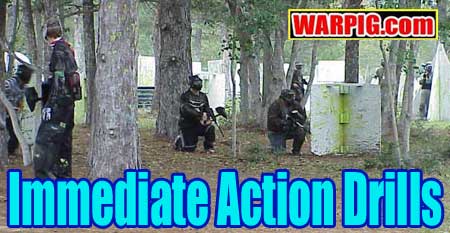  |
|
|
|
|
|
|
  |
|
|
|
|
|
|

What do you think? Add your comments in WARPIG's REC TALK Forum
|

Immediate Action Drills By Jon T. Harris When you play scenario games , and I mean really play scenario games, your team can benefit from practicing Immediate Action Drills. The Military calls them Battle Drills. I will attempt to help you understand how the proper use of proven tactics will make you and your team better players. The term, enemy and opposing team are interchangeable in these articles and throughout the website. These small routines can mean the difference in living and getting splattered in paint on the scenario field. The military sees these drills as so important that units fail combat readiness tests if they cant perform them adequately. My squad practiced these drills and many more weekly. I can tell you from experience, they work. Are they hard? Not on the face of them but coordination is the key. That, and everyone needs to be working on the same sheet of paper. I remember practicing crossing the same road maybe 50 times in a day until I was satisfied we had it right. Then we would do it again with different people in each other’s position. Everyone had to know the other person's job. So what are immediate action drills and why are they so important? For our purposes, these questions need one more part. Why do I need these for paintball? Well, the answers are pretty simple but lets go through them one at a time. What is an Immediate Action Drill?
Why are they so important?
Why do I need these for paintball?
The tactics I’m showing here are real world and practiced. They are proven in real combat and I personally have seen them make the difference in a REALLY bad day and one I’m able to write about. Coincidently, I’ve used these drills in paintball with just a little bit of practice by only a couple of players on the team and even that was enough to completely annihilate the other team. So lets start:
Given you have three members of your team moving down either side of a trail. Your team moves slowly and quietly. This could be a patrol (like in a long game) or your team is moving to an objective like the other side’s bunker. You stagger your team. Everyone knows where his or her team members are and can see them. The lead member makes contact with the enemy. He may simply see them, or be shot at by them, but the contact is made. That lead member must immediately determine if your team has been seen or not, because that will decide your best response. For this drill assume your team has been compromised and all Hell is about to break loose. Your team responds by going into its immediate action drill. For this situation we will use the assault drill. Your lead member makes contact. While yelling “CONTACT FRONT,” he takes cover and shoots. The rest of the team echoes the info, “CONTACT FRONT,” and rushes forward. Remember, your lead guy is in a world of dog doo so the rest of the team needs to get moving fast. Remember the word immediate? The team moves forward in a quick leapfrog style. First, the lead guy who has already taken cover lays down covering fire. It is not so important that he hit anyone, just that he keep them from sending paint in the direction of your team. The second member moves up a to a position forward but to the other side of the trail if possible of the lead member, but not in his line of fire. He then fires at the enemy while taking cover. The third member is already moving. He passes #2 and does the same thing. Now the team member that was in the lead is the farthest back and they move up, repeating the drill. No one moves unless the other team members
are laying down covering fire.
There is another point that needs to be brought up here. If a team member runs out of ammo he yells "LOADING!" This lets the other members know that there is no fire coming from the loading member so the team waits until all are ready. When that team member is reloaded he signals by yelling “UP” or “READY!” The exact wording is up to the team, and you might consider picking some code words that aren’t so obvious to the opposing team. Whatever words you use, it is practice and drilling that will make them an automatic response. Loading under combat conditions and moving is another Immediate Action Drill and we will cover this in another article on teamwork. This advancing leap-frog technique continues until either the enemy is severely painted, runs away or you find you have bitten off more than you can handle. About the author Jon T. Harris has served in civilian SWAT and hostage negotiation teams in Texas from 1977 through 1988. In 88, Jon joined the US Army and served in rapid deployment and small independent units in Europe until he retired due to combat related injuries. Jon was rated as The NCO of the year while serving in Europe and is a permanent member of the prestigious US Army Europe Morales Club. Jon is a published author. He
has written several articles on small unit training in the US Army magazine
as well as several short stories. He is the author of the action adventure
novel "Breakpoint" which is at the publisher now and is the tactical adviser
and owner of Tacticalmarkers.com,
a site dedicated to scenario and military simulation paintball use. His
interests are in Scenario Play and Mil/Rec games.
|
| Copyright © 1992-2019
Corinthian Media Services. WARPIG's webmasters can be reached through our feedback form. All articles and images are copyrighted and may not be redistributed without the written permission of their original creators and Corinthian Media Services. The WARPIG paintball page is a collection of information and pointers to sources from around the internet and other locations. As such, Corinthian Media Services makes no claims to the trustworthiness or reliability of said information. The information contained in, and referenced by WARPIG, should not be used as a substitute for safety information from trained professionals in the paintball industry. |